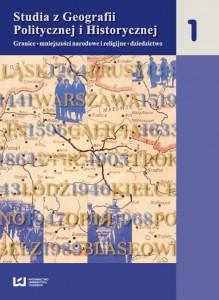Dlaczego razem? Uwagi o relacjach między geograficzno-historyczną i geograficzno-polityczną perspektywą metodologiczną i poznawczą
DOI:
https://doi.org/10.18778/2300-0562.01.02Słowa kluczowe:
geografia polityczna, geografia historycznaAbstrakt
W artykule dokonano uzasadnienia tytułowego powiązania geografii politycznej i historycznej. W tym celu przeprowadzono analizę relacji między obiema dyscyplinami, podejmującą kwestie ich genezy, kierunków rozwojowych, treści, zakresu i miejsca w systemie nauk, a także ustanowienia ram organizacyjnych dla rozwoju tych dyscyplin w łódzkim ośrodku geograficznym.
Bibliografia
Arnold S., 1929, Geografia historyczna, jej zadania i metody, Warszawa.
Google Scholar
Arnold S., 1951, Geografia historyczna Polski, Warszawa.
Google Scholar
Baczwarow M., Suliborski A., 2002, Kompendium wiedzy o geografii politycznej i geopolityce. Terminologia, Warszawa–Łódź.
Google Scholar
Barbarg J., 1987, Geografia polityczna ogólna, Warszawa.
Google Scholar
Blaksell M., 2005, Geografia polityczna, Warszawa.
Google Scholar
Bohdanowicz J., Dzięcielski M., 1994, Zarys geografii politycznej i historycznej cywilizacji, Gdańsk.
Google Scholar
Chłapowski K., 1996, W sprawie pojęcia „geografia historyczna”, „Przegląd Geograficzny”, 68 (3–4), s. 479–482.
Google Scholar
Czas i przestrzeń w naukach geograficznych. Wybrane problemy geografii historycznej, 2008, Kulesza M. (red.), Łódź.
Google Scholar
Czerny F., 1882, Dzisiejszy stan geografii, jej badań i wiadomości, t. 1, Warszawa.
Google Scholar
Dobrowolska M., 1953, Przedmiot i metoda geografii historycznej, „Przegląd Geograficzny”, 25 (1), s. 57–71.
Google Scholar
Eberhardt P., 2008, Przedmowa, [w:] Eberhardt P. (red.), Problematyka geopolityczna ziem polskich, „Prace Geograficzne”, 218, Warszawa.
Google Scholar
Fleszar M., 1958, W sprawie badań nad geografią polityczną w Polsce, „Przegląd Geograficzny”, 30 (1), s. 97–110.
Google Scholar
Gloger Z., 1991, Geografia historyczna ziem dawnej Polski, Warszawa.
Google Scholar
Janczak J., 1993, Geografia historyczna – samodzielna dyscyplina czy tylko nauka pomocnicza?, [w:] Chrobaczyński J., Jureczko A., Śliwa M. (red.), Ojczyzna bliższa i dalsza. Studia historyczne ofiarowane Feliksowi Kirykowi w sześćdziesiątą rocznicę urodzin, Kraków.
Google Scholar
Koneczny F., 1905, Geografia historyczna, Lwów.
Google Scholar
Koter M., Kulesza M., Sobczyński M., 1999, Geografia polityczna i historyczna regionu łódzkiego w badaniach Katedry Geografii Politycznej i Studiów Regionalnych, [w:] Nauki geograficzne a edukacja społeczeństwa, t. 2: Region Łódzki, Łódź.
Google Scholar
Kulesza M., 2009, Uwagi na temat geografii historycznej w Polsce po II wojnie światowej, [w:] Kulesza M., Geografia historyczna jako determinanta rozwoju nauk humanistycznych, Legnica–Łodź.
Google Scholar
Labuda G., 1953, Uwagi o przedmiocie i metodzie geografii historycznej, „Przegląd Geograficzny”, 25 (1), s. 5–56.
Google Scholar
Lanczkowski G., 1986, Wprowadzenie do religioznawstwa, Warszawa.
Google Scholar
Leszczycki S., 1962, Rozwój myśli geograficznej, [w:] Geografia powszechna, t. 1,Warszawa.
Google Scholar
Nowakowski S., 1933, Geografia jako nauka i dzieje odkryć geograficznych, Warszawa.
Google Scholar
Otok S., 1997, Geografia polityczna ogólna, Warszawa.
Google Scholar
Ratzel F., 1897, Politische Geographie, München.
Google Scholar
Romer E., 1969, O geografii. Rozważania historyczne i metodologiczne, Wrocław.
Google Scholar
Rykiel Z., 2006, Podstawy geografii politycznej, Warszawa.
Google Scholar
Sobczyński M., 2008, Historia geografii politycznej, [w:] Jackowski A., Liszewski S., Richling A., Historia geografii polskiej, Warszawa.
Google Scholar
Tyszkiewicz J., 1981, Człowiek w środowisku geograficznym Polski średniowiecznej, Warszawa.
Google Scholar
Tyszkiewicz J., 2003, Geografia historyczna Polski średniowiecznej w końcu XX stulecia [w:] Geografia historyczna Polski w średniowieczu. Zbiór studiów, Warszawa.
Google Scholar
Wielka encyklopedia powszechna, t. 4, 1964, Warszawa.
Google Scholar
Wyrwicz K., 1768, Geografia czasów teraźniejszych, Wilno.
Google Scholar
Zagadnienia geografii historycznej osadnictwa w Polsce. Materiały konferencyjne, 1994, Koter M., Tkocz J. (red.), Toruń–Łodź.
Google Scholar
Pobrania
Opublikowane
Jak cytować
Numer
Dział
Licencja

Utwór dostępny jest na licencji Creative Commons Uznanie autorstwa – Użycie niekomercyjne – Bez utworów zależnych 4.0 Międzynarodowe.








